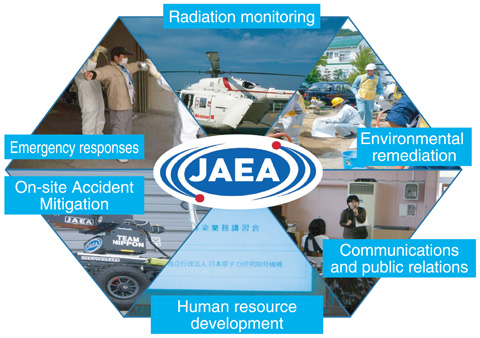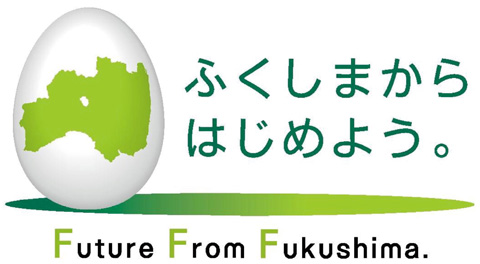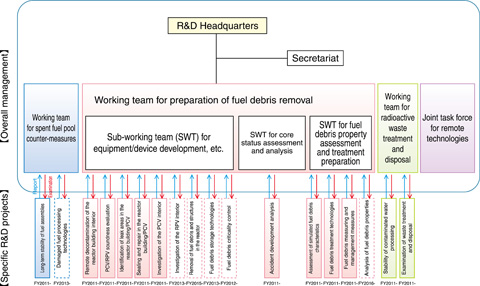
Fig.1-1 JAEA’s post-accident efforts

Fig.1-2 Logo created by Fukushima Prefecture, symbolizing rebuilding of Fukushima with the cooperation of all Fukushimans

Fig.1-3 Government and TEPCO mid-to-long-term R&D framework
JAEA has undertaken diverse action for post-accident Fukushima (Fig.1-1, Fig.1-2).
Emergency Response to the Great East Japan Earthquake
JAEA, as a designated public institution according to the Basic Law on Natural Disasters, took action in response to the Great East Japan Earthquake that occurred on March 11, 2011. In response to a request by the government, JAEA dispatched seven technical experts equipped with monitoring devices on March 12; the technical experts were scrambled by the Japan Self-Defense Force helicopter from the Hyakuri air base in Ibaraki Prefecture. JAEA sent a total of 45318 staff members to Fukushima between this first action and March 31, 2012.
Radiation Monitoring
Reliable and accurate data relating to environmental radioactivity are required for assessment of health effects and decontamination plans. Our monitoring- and mapping-related activities include air radiation dose rate mapping (Topic 1-1), simulation of radionuclide transport in seawater (Topic 1-2), collection and publication of environmental radioactivity m onitoring data (Topic 1-3), and measurement of atmospheric radioactive materials by IMS (Topic 1-4). Additionally, under the contract with MEXT, JAEA has also conducted measurement and mapping of radionuclides deposited on the ground surface in Fukushima (Topic 1-5) and aerial radiation dose monitoring throughout Japan (Topic 1-6); the resulting maps are available on the MEXT homepage.
Environmental Remediation
Some of the major contributions of JAEA include d econtamination- or cleanup-related activities for the environmental remediation of Fukushima. JAEA released decontamination guidelines and catalogs of decontamination techniques to assist in the cleanup of environment contaminated with radioactive materials (Topic 1-7). The decontamination pilot project (Topic 1-8) involved a c omprehensive demonstration, providing practical information on how to clean up radioactive contamination that had spread throughout residential areas. Based on the experience and technical expertise obtained as a result of these activities, which were conducted under contract with the government, JAEA has been able to offer various forms of technical assistance to local authorities in Fukushima and adjacent prefectures, and has supported environmental remediation planning in these prefectures.
JAEA, as a R&D institute, has been engaged in varied R&D: soil washing for farmland reparation (Topic 1-9, 1-10), trial decontamination of playground lots in residential areas (Topic 1-11), computer simulation to predict a nd estimate the effects of areal decontamination (Topic 1-12), simple and convenient methods for measurement of radioactivity (Topic 1-13), cesium adsorbents (Topic 1-14, 1-15), verification of the effectiveness of post-accident preventive measures (Topic 1-16), and investigation of forest contamination (Topic 1-17).
Communications and Public Relations
JAEA has held question and answer sessions discussing radiation and health: JAEA technical members have been dispatched to schools in Fukushima Prefecture (from kindergartens to junior high schools) upon request. After briefing on radiation, JAEA members talked face to face with parents and teachers, answering their questions about radiation and its health effects. Since July 2011, 178 sessions have been held and a total of around 16746 people attended.
Human Resources Development
Upon request from the government (the Agency for Natural Resources and Energy) and Fukushima Prefecture, JAEA initiated training sessions to foster development of radiation management staff and decontamination workers.
Onsite Accident Mitigation
Immediately after the accident, JAEA has been providing technical advice to the government and the Tokyo Electric P ower Company, Incorporated (TEPCO), while simultaneously initiating research into mid- and long-term post-accident mitigation. Data acquisition and analysis are underway for t he progression of core meltdown (Topic 1-18), and analysis is b eing conducted on reactor core behavior in Unit 1 (Topic 1-19) and Unit 2 (Topic 1-20) of the TEPCO ’s Fukushima Daiichi Nuclear Power Station (NPS). Additionally, generation of radioactive waste by treatment of contaminated w ater used for cooling pools (Topic 1-21), strontium absorption (Topic 1-22), and hydrogen gas generation from spent zeolite (Topic 1-23) are also being studied. Water gauges that can work under extremely high radiation fields are required, and their development is also one of JAEA ’s R&D topics (Topic 1-24). JAEA ’s future R&D efforts will follow the government’s and TEPCO ’s mid-to-long-term R&D roadmap (Fig.1-3). JAEA will be extensively involved in fuel assembly management and remotely controlled decontamination technologies for the TEPCO ’s Fukushima Daiichi NPS.
Response from and Involvement of JAEA Branches
Technical support, including staff attachment, has involved the cooperation of all JAEA branches. JAEA colleagues played various roles, including those in the Emergency Operations Center (EOC) of MEXT: environmental radiation monitoring, decontamination pilot projects, providing local authorities with technical assistance for decontamination, communication and public relations, support for temporary return of evacuees, and so on.
Tsuruga Head Office
The head office sent staff to Fukushima Medical University to join medical teams prepared for high exposure to radiation.
Tokai Research and Development Center, Nuclear Science Research Institute
The institute conducted analyses of environmental samples such as soil, contaminated water generated by reactor core cooling, and radionuclide-adsorbed zeolite.
Tokai Research and Development Center, Nuclear Fuel Cycle Engineering Laboratories
The laboratories conducted analyses of treatment of accumulated water, molten fuel, and cesium behavior during incineration of cesium-contained wastes.
Oarai Research and Development Center
The center conducted salt immersion tests utilizing storage capsules for spent fuel at their Fugen Decommissioning Engineering Center, in order to evaluate long-term safety of fuel assemblies taken from the spent fuel pools of the TEPCO ’s Fukushima Daiichi NPS. Remotely controlled decontamination was attempted at the Fugen plant.
Naka Fusion Institute
The institute conducted measurements of the radioactivity of water in the region of Fukushima.
Takasaki Advanced Radiation Research Institute
Using their γ-ray irradiation facility, the institute conducted an irradiation test for Quince, a disaster relief robot introduced to survey the inside of power plant b uildings. They also performed simulation tests of hydrogen gas generation by radiolysis of seawater.
Horonobe Underground Research Center
The center dispatched staff members to the Headquarters of Fukushima Partnership Operations and EOC of MEXT.
Tono Geoscience Center
The center conducted analyses of groundwater flow around the Fukushima Daiichi site.
Ningyo-toge Environmental Engineering Center
Computer simulation was made to analyze cesium behavior during incineration of contaminated debris. They also studied on the effects of ground cover plants for land restoration.
<Previous: About This Publication and the Outline Organization of JAEA | Next: 1-1 >